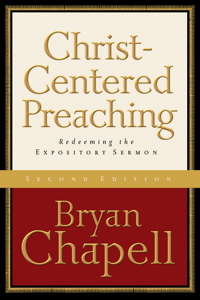|
|
||
Christ Centered Preaching
If you want to read a great book on biblical preaching, then you should consider Christ-Centered Preaching by Bryan Chappell. What is a Sermon?In chapter two, Bryan Chappell defines what is a sermon. He points out that a sermon is not a series of statements. A sermon must possess unity, purpose and application. Unity means the sermon is about one thing. It has one theme and one unifying concept. The preacher should be able to define his message in one sentence. The unity of the sermons can be summed up by the following maxim: The main thing is to keep the main thing the main thing. Purpose is all about The Fallen Condition Focus (FCF). The FCF refers to the connection between original hearers and contemporary hearers. To discover the FCF, preachers need to examine the text in question: what does the text say, what concerns does the text address and how does this apply to the original hearers and contemporary hearers? Application is not about more information but transformation. What does this text say to me today? What must I do to live out this text today in my life? Application is transformation. We are not simply ministers of information but ministers of Christ's transformation. How to Prepare a Sermon?In chapter five, Bryan Chappell defines the path of preparation for a sermon. First, he looks at three questions that relate to the preacher's research of the meaning of the text in question.
The first three questions are about the preacher doing enough research in order to understand the scope and the particulars of the text. Second, he looks at three questions that determine how the preacher will relate the text's meaning to original and contempory hearers.
Ministers answer ctirtical questions that define the path of explanation by following four steps in their sermon preparation.
Preview 16 Preaching Sermons From Philippians by clicking on Preaching Sermons. How To Outline and Structure the SermonOnce you have worked the text, you will need to create the sermon outline and structure. Chappell states that a well-planned sermon begins with a good outline - a good outline serves a simply purpose, it keeps listeners and the speaker oriented throughout the message. Chappell points out several general sermon outline features:
Chappell also points out several specific sermon outline features:
When you become skilled in the science and art of sermon outlining, you will find this process much easier. It does take time, so stick with it for the rewards are great. How to Preach the SermonThere are several components to a sermon. However, one important component is getting the message across - this is related to preaching the sermon. A balanced approach to preaching a sermon involves:
A good illustration can help people understand what the text is saying to them. When it comes to discipline, I also remember this quote. Motivation gets you going, but discipline keeps you growing. Just this short quote illustrated to me the need for discipline in my Christian life if I wanted to grow in the Lord. Preview 16 Preaching Sermons From Philippians by clicking on Preaching Sermons. There is so much more to learn from Bryan Chappell. If you want to learn how to create powerful sermons, then you need to read Christ Centered Preaching. Check it out - Christ-Centered Preaching. Related Resources and Tips |
SEARCH THIS SITE |
|
|
|
||
|
Return to top
Homepage | Free Topical Sermons | Free Expository Sermons | Free Evangelistic Sermons | Free Christmas Sermons Free Easter Sermons | Free Mothers Day Sermons | Free Short Sermons | Free Sermonettes | Free Wedding Messages Free Sermons For Young People | Free Sermons For Youth | Free Sermons For Children | Free Online Sermons Free Sermon Outlines | Free Sermon Illustrations | Sermons Sermons Sermons | How To Write A Sermon | How To Write A Sermon Outline Writing A Funeral Sermon | Web Builders For Churches | Web Hosting For Churches | Web Design For Churches | Web Pages For Churches Web Keywords For Churches | Google Adsense For Churches | Site Map Disclaimer/Disclosure | Sermon Information |
||
|
© Copyright 2008 -
All Rights Reserved No reproduction permitted without permission www.more-free-online-sermons.com Christ Centered Preaching Book Review | ||




